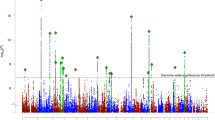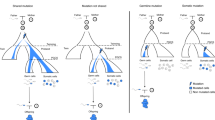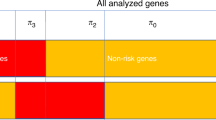Abstract
Classical twin research focused on differentiating genetic factors from environmental factors by comparing the concordance rate between monozygotic (MZ) and dizygotic twins. On the other hand, recent twin research tries to identify genetic or epigenetic differences between MZ twins discordant for mental disorders. There are a number of reports of MZ twins discordant for genetic disorders caused by genetic or epigenetic differences of known pathogenic genes. In the case of mental disorder research, for which the causative gene has not been established yet, we are trying to identify the ‘pathogenic gene’ by comprehensive analysis of genetic or epigenetic difference between discordant MZ twins. To date, no compelling evidence suggesting such difference between MZ twins has been reported. However, if the genetic or epigenetic difference responsible for the discordant phenotype is found, it will have impact on the biology of mental disorder, in which few conclusive molecular genetic evidences have been obtained.
This is a preview of subscription content, access via your institution
Access options
Subscribe to this journal
Receive 12 print issues and online access
$259.00 per year
only $21.58 per issue
Buy this article
- Purchase on Springer Link
- Instant access to full article PDF
Prices may be subject to local taxes which are calculated during checkout
Similar content being viewed by others
References
Torrey EF, Taylor EH, Bracha HS, Bowler AE, McNeil TF, Rawlings RR et al. Prenatal origin of schizophrenia in a subgroup of discordant monozygotic twins. Schizophr Bull 1994; 20: 423–432.
Kunugi H, Urushibara T, Murray RM, Nanko S, Hirose T . Prenatal underdevelopment and schizophrenia: a case report of monozygotic twins. Psychiatry Clin Neurosci 2003; 57: 271–274.
Suddath RL, Christison GW, Torrey EF, Casanova MF, Weinberger DR . Anatomical abnormalities in the brains of monozygotic twins discordant for schizophrenia. N Engl J Med 1990; 322: 789–794.
Kurachi M . Pathogenesis of schizophrenia: Part I. Symptomatology, cognitive characteristics and brain morphology. Psychiatry Clin Neurosci 2003; 57: 3–8.
Polymeropoulos MH, Xiao H, Torrey EF, DeLisi LE, Crow T, Merril CR . Search for a genetic event in monozygotic twins discordant for schizophrenia. Psychiatry Res 1993; 48: 27–36.
Tsujita T, Niikawa N, Yamashita H, Imamura A, Hamada A, Nakane Y et al. Genomic discordance between monozygotic twins discordant for schizophrenia. Am J Psychiatry 1998; 155: 422–424.
Vincent JB, Kalsi G, Klempan T, Tatuch Y, Sherrington RP, Breschel T et al. No evidence of expansion of CAG or GAA repeats in schizophrenia families and monozygotic twins. Hum Genet 1998; 103: 41–47.
Nguyen GH, Bouchard J, Boselli MG, Tolstoi LG, Keith L, Baldwin C et al. DNA stability and schizophrenia in twins. Am J Med Genet 2003; 120B: 1–10.
Petronis A, Gottesman II, Kan P, Kennedy JL, Basile VS, Paterson AD et al. Monozygotic twins exhibit numerous epigenetic differences: clues to twin discordance? Schizophr Bull 2003; 29: 169–178.
McDonald P, Lewis M, Murphy B, O'Reilly R, Singh SM . Appraisal of genetic and epigenetic congruity of a monozygotic twin pair discordant for schizophrenia. J Med Genet 2003; 40: E16.
Cardno AG, Gottesman II . Twin studies of schizophrenia: from bow-and-arrow concordances to star wars Mx and functional genomics. Am J Med Genet 2000; 97: 12–17.
Petronis A, Gottesman II, Crow TJ, DeLisi LE, Klar AJ, Macciardi F et al. Psychiatric epigenetics: a new focus for the new century. Mol Psychiatry 2000; 5: 342–346.
Morgan HD, Sutherland HG, Martin DI, Whitelaw E . Epigenetic inheritance at the agouti locus in the mouse. Nat Genet 1999; 23: 314–318.
Rakyan VK, Chong S, Champ ME, Cuthbert PC, Morgan HD, Luu KV et al. Transgenerational inheritance of epigenetic states at the murine Axin(Fu) allele occurs after maternal and paternal transmission. Proc Natl Acad Sci U S A 2003; 100: 2538–2543.
Singh SM, Murphy B, O'Reilly R . Epigenetic contributors to the discordance of monozygotic twins. Clin Genet 2002; 62: 97–103.
Weaver IC, Cervoni N, Champagne FA, D'Alessio AC, Sharma S, Seckl JR et al. Epigenetic programming by maternal behavior. Nat Neurosci 2004; 7: 847–854.
Martinowich K, Hattori D, Wu H, Fouse S, He F, Hu Y et al. DNA methylation-related chromatin remodeling in activity-dependent BDNF gene regulation. Science 2003; 302: 890–893.
Chen WG, Chang Q, Lin Y, Meissner A, West AE, Griffith EC et al. Derepression of BDNF transcription involves calcium-dependent phosphorylation of MeCP2. Science 2003; 302: 885–889.
Machin GA . Some causes of genotypic and phenotypic discordance in monozygotic twin pairs. Am J Med Genet 1996; 61: 216–228.
Sakuntabhai A, Ruiz-Perez V, Carter S, Jacobsen N, Burge S, Monk S et al. Mutations in ATP2A2, encoding a Ca2+ pump, cause Darier disease. Nat Genet 1999; 21: 271–277.
Kondo S, Schutte BC, Richardson RJ, Bjork BC, Knight AS, Watanabe Y et al. Mutations in IRF6 cause Van der Woude and popliteal pterygium syndromes. Nat Genet 2002; 32: 285–289.
Gilbert B, Yardin C, Briault S, Belin V, Lienhardt A, Aubard Y et al. Prenatal diagnosis of female monozygotic twins discordant for Turner syndrome: implications for prenatal genetic counselling. Prenat Diagn 2002; 22: 697–702.
Wulfsberg EA, Wassel WC, Polo CA . Monozygotic twin girls with diploid/triploid chromosome mosaicism and cutaneous pigmentary dysplasia. Clin Genet 1991; 39: 370–375.
Marcus-Soekarman D, Hamers G, Velzeboer S, Nijhuis J, Loneus WH, Herbergs J et al. Mosaic trisomy 11p in monozygotic twins with discordant clinical phenotypes. Am J Med Genet 2004; 124A: 288–291.
Nonomura K, Kakizaki H, Fukuzawa N, Fujieda K, Harada N, Niikawa N et al. Monozygotic twins with discordant sexual phenotypes due to different ratios of mosaicism of 47,X,idic(Y),idic(Y)/46,X, idic(Y)/45,X. Endocr J 2002; 49: 497–501.
Costa T, Lambert M, Teshima I, Ray PN, Richer CL, Dallaire L . Monozygotic twins with 45,X/46,XY mosaicism discordant for phenotypic sex. Am J Med Genet 1998; 75: 40–44.
Singh SM, Murphy B, O'Reilly R . Monozygotic twins with chromosome 22q11 deletion and discordant phenotypes: updates with an epigenetic hypothesis. J Med Genet 2002; 39: e71.
Biousse V, Brown MD, Newman NJ, Allen JC, Rosenfeld J, Meola G et al. De novo 14484 mitochondrial DNA mutation in monozygotic twins discordant for Leber's hereditary optic neuropathy. Neurology 1997; 49: 1136–1138.
Blakely EL, He L, Taylor RW, Chinnery PF, Lightowlers RN, Schaefer AM et al. Mitochondrial DNA deletion in ‘identical’ twin brothers. J Med Genet 2004; 41: e19.
Degoul F, Diry M, Pou-Serradell A, Lloreta J, Marsac C . Myo-leukoencephalopathy in twins: study of 3243-myopathy, encephalopathy, lactic acidosis, and strokelike episodes mitochondrial DNA mutation. Ann Neurol 1994; 35: 365–370.
Penisson-Besnier I, Degoul F, Desnuelle C, Dubas F, Josi K, Emile J et al. Uneven distribution of mitochondrial DNA mutation in MERRF dizygotic twins. J Neurol Sci 1992; 110: 144–148.
Petronis A, Kennedy JL . Unstable genes—unstable mind? Am J Psychiatry 1995; 152: 164–172.
Helderman-van den Enden AT, Maaswinkel-Mooij PD, Hoogendoorn E, Willemsen R, Maat-Kievit JA, Losekoot M et al. Monozygotic twin brothers with the fragile X syndrome: different CGG repeats and different mental capacities. J Med Genet 1999; 36: 253–257.
Abbadi N, Philippe C, Chery M, Gilgenkrantz H, Tome F, Collin H et al. Additional case of female monozygotic twins discordant for the clinical manifestations of Duchenne muscular dystrophy due to opposite X-chromosome inactivation. Am J Med Genet 1994; 52: 198–206.
Tremblay JP, Bouchard JP, Malouin F, Theau D, Cottrell F, Collin H et al. Myoblast transplantation between monozygotic twin girl carriers of Duchenne muscular dystrophy. Neuromuscul Disord 1993; 3: 583–592.
Redonnet-Vernhet I, Ploos van Amstel JK, Jansen RP, Wevers RA, Salvayre R, Levade T . Uneven X inactivation in a female monozygotic twin pair with Fabry disease and discordant expression of a novel mutation in the alpha-galactosidase A gene. J Med Genet 1996; 33: 682–688.
Kruyer H, Mila M, Glover G, Carbonell P, Ballesta F, Estivill X . Fragile X syndrome and the (CGG)n mutation: two families with discordant MZ twins. Am J Hum Genet 1994; 54: 437–442.
Weksberg R, Shuman C, Caluseriu O, Smith AC, Fei YL, Nishikawa J et al. Discordant KCNQ1OT1 imprinting in sets of monozygotic twins discordant for Beckwith-Wiedemann syndrome. Hum Mol Genet 2002; 11: 1317–1325.
Maher ER, Brueton LA, Bowdin SC, Luharia A, Cooper W, Cole TR et al. Beckwith-Wiedemann syndrome and assisted reproduction technology (ART). J Med Genet 2003; 40: 62–64.
Gicquel C, Gaston V, Mandelbaum J, Siffroi JP, Flahault A, Le Bouc Y . In vitro fertilization may increase the risk of Beckwith-Wiedemann syndrome related to the abnormal imprinting of the KCN1OT gene. Am J Hum Genet 2003; 72: 1338–1341.
Halliday J, Oke K, Breheny S, Algar E, Amor DJ . Beckwith-Wiedemann syndrome and IVF: a case-control study. Am J Hum Genet 2004; 75: 526–528.
Niemitz EL, Feinberg AP . Epigenetics and assisted reproductive technology: a call for investigation. Am J Hum Genet 2004; 74: 599–609.
Kazazian Jr HH, Wong C, Youssoufian H, Scott AF, Phillips DG, Antonarakis SE . Haemophilia A resulting from de novo insertion of L1 sequences represents a novel mechanism for mutation in man. Nature 1988; 332: 164–166.
Wallace MR, Andersen LB, Saulino AM, Gregory PE, Glover TW, Collins FS . A de novo Alu insertion results in neurofibromatosis type 1. Nature 1991; 353: 864–866.
Karlsson H, Bachmann S, Schroder J, McArthur J, Torrey EF, Yolken RH . Retroviral RNA identified in the cerebrospinal fluids and brains of individuals with schizophrenia. Proc Natl Acad Sci USA 2001; 98: 4634–4639.
Karlsson H, Schroder J, Bachmann S, Bottmer C, Yolken RH . HERV-W-related RNA detected in plasma from individuals with recent-onset schizophrenia or schizoaffective disorder. Mol Psychiatry 2004; 9: 12–13.
Deb-Rinker P, O'Reilly RL, Torrey EF, Singh SM . Molecular characterization of a 2.7-kb, 12q13-specific, retroviral-related sequence isolated by RDA from monozygotic twin pairs discordant for schizophrenia. Genome 2002; 45: 381–390.
Deb-Rinker P, Klempan TA, O'Reilly RL, Torrey EF, Singh SM . Molecular characterization of a MSRV-like sequence identified by RDA from monozygotic twin pairs discordant for schizophrenia. Genomics 1999; 61: 133–144.
Petronis A . Epigenetics and bipolar disorder: new opportunities and challenges. Am J Med Genet C Semin Med Genet 2003; 123: 65–75.
McMahon FJ, Stine OC, Meyers DA, Simpson SG, DePaulo JR . Patterns of maternal transmission in bipolar affective disorder. Am J Hum Genet 1995; 56: 1277–1286.
Kato T, Winokur G, Coryell W, Keller MB, Endicott J, Rice J . Parent-of-origin effect in transmission of bipolar disorder. Am J Med Genet 1996; 67: 546–550.
Kornberg JR, Brown JL, Sadovnick AD, Remick RA, Keck Jr PE, McElroy SL et al. Evaluating the parent-of-origin effect in bipolar affective disorder. Is a more penetrant subtype transmitted paternally? J Affect Disord 2000; 59: 183–192.
Stine OC, Xu J, Koskela R, McMahon FJ, Gschwend M, Friddle C et al. Evidence for linkage of bipolar disorder to chromosome 18 with a parent-of-origin effect. Am J Hum Genet 1995; 57: 1384–1394.
Lambert D, Gill M . Evaluation of parent-of-origin effect in bipolar affective disorder relating to susceptibility loci on chromosome 18. Bipolar Disord 2002; 4(Suppl 1): 31–32.
Schulze TG, Buervenich S, Badner JA, Steele CJ, Detera-Wadleigh SD, Dick D et al. Loci on chromosomes 6q and 6p interact to increase susceptibility to bipolar affective disorder in the National Institute of Mental Health genetics initiative pedigrees. Biol Psychiatry 2004; 56: 18–23.
McInnis MG, Lan TH, Willour VL, McMahon FJ, Simpson SG, Addington AM et al. Genome-wide scan of bipolar disorder in 65 pedigrees: supportive evidence for linkage at 8q24, 18q22, 4q32, 2p12, and 13q12. Mol Psychiatry 2003; 8: 288–298.
Kanai H, Sawa A, Chen RW, Leeds P, Chuang DM . Valproic acid inhibits histone deacetylase activity and suppresses excitotoxicity-induced GAPDH nuclear accumulation and apoptotic death in neurons. Pharmacogenomics J 2004; 4: 336–344.
Carney MW, Chary TK, Bottiglieri T, Reynolds EH, Toone BK . Switch mechanism in affective illness and oral S-adenosylmethionine (SAM). Br J Psychiatry 1987; 150: 724–725.
Detich N, Hamm S, Just G, Knox JD, Szyf M . The methyl donor S-adenosylmethionine inhibits active demethylation of DNA: a candidate novel mechanism for the pharmacological effects of S-adenosylmethionine. J Biol Chem 2003; 278: 20812–20820.
Gottesman II, Bertelsen A . Confirming unexpressed genotypes for schizophrenia. Risks in the offspring of Fischer's Danish identical and fraternal discordant twins. Arch Gen Psychiatry 1989; 46: 867–872.
Petronis A, Paterson AD, Kennedy JL . Schizophrenia: an epigenetic puzzle? Schizophr Bull 1999; 25: 639–655.
Husted J, Scutt LE, Bassett AS . Paternal transmission and anticipation in schizophrenia. Am J Med Genet 1998; 81: 156–162.
Stober G, Haubitz I, Franzek E, Beckmann H . Parent-of-origin effect and evidence for differential transmission in periodic catatonia. Psychiatr Genet 1998; 8: 213–219.
DeLisi LE, Razi K, Stewart J, Relja M, Shiedls G, Smith AB et al. No evidence for a parent-of-origin effect detected in the pattern of inheritance of schizophrenia. Biol Psychiatry 2000; 48: 706–709.
Klaning U, Mortensen PB, Kyvik KO . Increased occurrence of schizophrenia and other psychiatric illnesses among twins. Br J Psychiatry 1996; 168: 688–692.
Tremolizzo L, Carboni G, Ruzicka WB, Mitchell CP, Sugaya I, Tueting P et al. An epigenetic mouse model for molecular and behavioral neuropathologies related to schizophrenia vulnerability. Proc Natl Acad Sci USA 2002; 99: 17095–17100.
Deb P, Klempan TA, O'Reilly RL, Singh SM . Search for retroviral related DNA polymorphisms using RAPD PCR in schizophrenia. Biochim Biophys Acta 1999; 1453: 216–220.
Brando LJ, Yolken R, Herman MM, Kleinman JE, Ross CA, Torrey EF . Analysis of the DRPLA triplet repeat in brain tissue and leukocytes from schizophrenics. Psychiatr Genet 1996; 6: 1–5.
Hatada I, Hayashizaki Y, Hirotsune S, Komatsubara H, Mukai T . A genomic scanning method for higher organisms using restriction sites as landmarks. Proc Natl Acad Sci USA 1991; 88: 9523–9527.
Friedhoff AJ, Miller JC, Basham DA . A subtracted probe derived from lymphocytes of twins discordant for schizophrenia hybridizes to selective areas of rat brain. Biol Psychiatry 1995; 37: 127–131.
Zumarraga M, Andia I, Davila R, Miller JC, Friedhoff AJ . Expression in normals and in subjects with schizophrenia of a novel gene fragment originally isolated from monozygotic twins discordant for schizophrenia. Genet Mol Biol 2004; 27: 17–21.
Bertelsen A, Harvald B, Hauge M . A Danish twin study of manic-depressive disorders. Br J Psychiatry 1977; 130: 330–351.
Kakiuchi C, Iwamoto K, Ishiwata M, Bundo M, Kasahara T, Kusumi I et al. Impaired feedback regulation of XBP1 as a genetic risk factor for bipolar disorder. Nat Genet 2003; 35: 171–175.
Kakiuchi C, Kato T . Lithium response and −116C/G polymorphism of XBP1 in Japanese patients with bipolar disorder. Int J Neuropsychopharmacol 2005; 8: 1–2.
Cichon S, Buervenich S, Kirov G, Akula N, Dimitrova A, Green E et al. Lack of support for a genetic association of the XBP1 promoter polymorphism with bipolar disorder in probands of European origin. Nat Genet 2004; 36: 783–784, author reply 784–785.
Chen W, Duan S, Zhou J, Sun Y, Zheng Y, Gu N et al. A case–control study provides evidence of association for a functional polymorphism −197C/G in XBP1 to schizophrenia and suggests a sex-dependent effect. Biochem Biophys Res Commun 2004; 319: 866–870.
Kakiuchi C, Ishiwata M, Umekage T, Tochigi M, Kohda K, Sasaki T et al. Association of the XBP1 -116C/G polymorphism with schizophrenia in Japanese population. Psychiatry Clin Neurosci 2004; 58: 438–440.
Kakiuchi C, Nanko S, Kunugi H, Kato T . Reply to ‘Lack of support for a genetic association of the XBP1 promoter polymorphism with bipolar disorder in probands of European origin’. Nat Genet 2004; 36: 784–785.
Kusumi I, Ohmori T, Kohsaka M, Ito M, Honma H, Koyama T . Chronobiological approach for treatment-resistant rapid cycling affective disorders. Biol Psychiatry 1995; 37: 553–559.
Vilain A, Bernardino J, Gerbault-Seureau M, Vogt N, Niveleau A, Lefrancois D et al. DNA methylation and chromosome instability in lymphoblastoid cell lines. Cytogenet Cell Genet 2000; 90: 93–101.
Neidhart M, Rethage J, Kuchen S, Kunzler P, Crowl RM, Billingham ME et al. Retrotransposable L1 elements expressed in rheumatoid arthritis synovial tissue: association with genomic DNA hypomethylation and influence on gene expression. Arthritis Rheum 2000; 43: 2634–2647.
Edwards J . Painless skin biopsy. Lancet 1960; i: 496.
Zardo G, Tiirikainen MI, Hong C, Misra A, Feuerstein BG, Volik S et al. Integrated genomic and epigenomic analyses pinpoint biallelic gene inactivation in tumors. Nat Genet 2002; 32: 453–458.
Hatada I, Kato A, Morita S, Obata Y, Nagaoka K, Sakurada A et al. A microarray-based method for detecting methylated loci. J Hum Genet 2002; 47: 448–451.
Ushijima T, Morimura K, Hosoya Y, Okonogi H, Tatematsu M, Sugimura T et al. Establishment of methylation-sensitive-representational difference analysis and isolation of hypo- and hypermethylated genomic fragments in mouse liver tumors. Proc Natl Acad Sci USA 1997; 94: 2284–2289.
Suzuki H, Gabrielson E, Chen W, Anbazhagan R, van Engeland M, Weijenberg MP et al. A genomic screen for genes upregulated by demethylation and histone deacetylase inhibition in human colorectal cancer. Nat Genet 2002; 31: 141–149.
Author information
Authors and Affiliations
Corresponding author
Rights and permissions
About this article
Cite this article
Kato, T., Iwamoto, K., Kakiuchi, C. et al. Genetic or epigenetic difference causing discordance between monozygotic twins as a clue to molecular basis of mental disorders. Mol Psychiatry 10, 622–630 (2005). https://doi.org/10.1038/sj.mp.4001662
Received:
Revised:
Accepted:
Published:
Issue Date:
DOI: https://doi.org/10.1038/sj.mp.4001662
Keywords
This article is cited by
-
Technical strategy for monozygotic twin discrimination by single-nucleotide variants
International Journal of Legal Medicine (2024)
-
Influence of adjuvant Coenzyme Q10 on inflammatory and oxidative stress biomarkers in patients with bipolar disorders during the depressive episode
Molecular Biology Reports (2019)
-
Somatic mutations in disorders with disrupted brain connectivity
Experimental & Molecular Medicine (2016)
-
Fgf signaling controls the telencephalic distribution of Fgf-expressing progenitors generated in the rostral patterning center
Neural Development (2015)
-
Discordant Transsexualism in Male Monozygotic Twins: Neuroanatomical and Psychological Differences
Archives of Sexual Behavior (2014)



